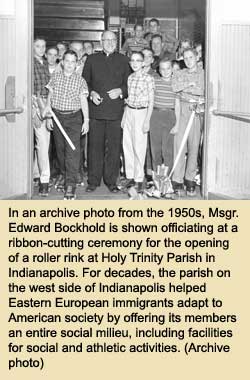Holy Trinity Parish begins
centennial celebrations
By Sean Gallagher
 One hundred years ago, immigrants from Eastern Europe were settling in a neighborhood on the west side of Indianapolis known as Haughville.
One hundred years ago, immigrants from Eastern Europe were settling in a neighborhood on the west side of Indianapolis known as Haughville.
Many of them were Catholic and, in response, Indianapolis Bishop Francis Silas Chatard established Holy Trinity Parish on April 29, 1906.
On that day, the parish’s first-ever
pastor, Father Joseph Lavric, celebrated the faith community’s first Mass in a rented hall at 731 N. Warman Ave. in Haughville. Father Lavric was joined by 720 worshippers.
On the same day 100 years later, Archbishop Daniel M. Buechlein celebrated a Mass honoring Holy Trinity Parish’s centennial at the current parish church, now at 2618 W. St. Clair St. in Indianapolis.
Father John McCaslin, the parish’s administrator since the start of the year, joined the archbishop on the occasion.
In an interview before the event, which kicked off a series of centennial celebrations scheduled throughout the year, Father McCaslin spoke about the importance of the anniversary.
“I think this will bring about a celebration of these 100 years, but also will bring some energy and excitement into the community [for the future] so that we’ll begin to think about not just what we’ve been but what we’re going to be,” he said.
For the first 48 years of its history, Holy Trinity was a national parish without geographical borders. It was intended to serve the needs of Slovenian Catholics, although its members in those early days also had moved to Indianapolis from Hungary and Poland.
Although it is no longer a national parish, the members of Holy Trinity still value their Eastern European heritage and sing Slovenian hymns at Masses on Christmas, Easter and other holy days during the liturgical year.
At the same time, the multicultural makeup of Holy Trinity’s members has expanded over the past several decades as the neighborhood around the parish has changed. Today, African-Americans make up approximately 10 percent of its members.
Sylvia Stanfield, 83, has been a member of the parish her entire life and has always lived just two blocks away from the church.
Her own family was Slovenian and, to this day, she can still speak her parents’ native tongue. During a recent interview, she acknowledged the varied ethnicities in the parish in its early days, describing it as a “mixture” where “everyone was friendly with one another.”
She said that it is the same today with a more diverse population than in the past.
“It’s still good,” Stanfield said. “Everybody is together. We have a different kind of arrangement of people, but everybody likes each other. Everybody gets along. And that’s good.”
In its beginning, Holy Trinity Parish helped Eastern European immigrants ease into American society in the same way that many other ethnic parishes did across the country: by serving as the entire social milieu for its members.
Holy Trinity Parish didn’t just offer Catholics in the neighborhood the celebration of the sacraments, formation in the faith and a Catholic school education. It also was a place for social events, such as dances and athletic activities.
Father Kenneth Taylor, who was the second-longest tenured pastor of Holy Trinity Parish, having led it for nearly two decades, recalled how much members of the parish valued this aspect of their history.
“Even after 20 years, people kept telling me the history of the parish like I had never heard it before,” he said with a laugh. “[They would say] ‘Did you know they had a roller skating rink in the gym? Did you know that this happened, and that that happened and that there was roller skating in the gym?’ People just constantly over the years kept telling me that they used to roller skate up in that gym.”
To this day, members of the parish continue to bake and sell poticas, an Eastern European pastry.
The various pastors of Holy Trinity Parish played an important part in its social network.
Msgr. Edward Bockhold led Holy Trinity Parish for almost a third of its history, from 1938 to 1969.
“He was like a father to all of us,” said Holy Trinity Parish pastoral associate Sue Ann Yovanovich, who grew up in the parish in the 1940s and 1950s. “He was always there when we needed him. He was there at our social events. He was there when we had a death. He was just one of our family.”
As the neighborhood around the parish changed, Holy Trinity Parish’s ministry to the neighborhood continued, although in a different way. For more than 20 years, it aided a large number of African-Americans in the area through its child daycare services.
The West Deanery parish continues to offer similar services to older adults. And it collaborates with organizations, such as the Westside Community Organization and Habitat for Humanity, to improve housing in the area.
Although his tenure at the parish has just begun, Father McCaslin is looking forward to continuing Holy Trinity Parish’s leadership in its neighborhood.
“Holy Trinity has been an anchor in the neighborhood,” he said. “And so there’s a credibility that comes with longevity and the stability of having that faith community there. I look forward to establishing greater relationships so we can begin to see how Holy Trinity is a leader in our community.” †
 One hundred years ago, immigrants from Eastern Europe were settling in a neighborhood on the west side of Indianapolis known as Haughville.
One hundred years ago, immigrants from Eastern Europe were settling in a neighborhood on the west side of Indianapolis known as Haughville.